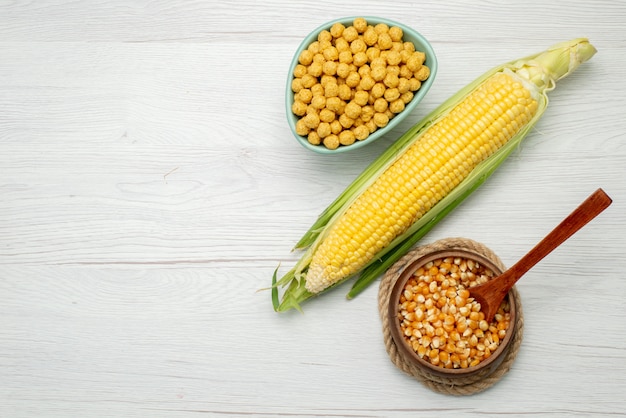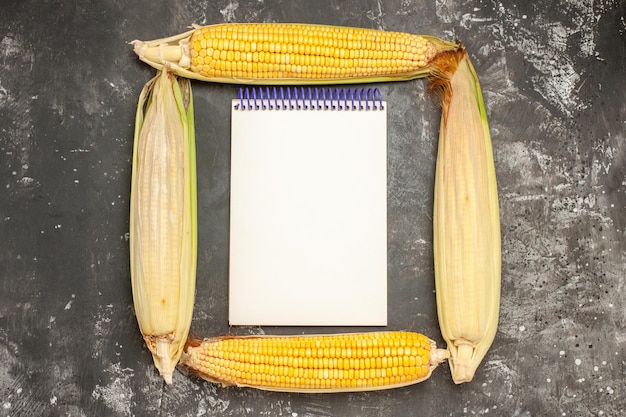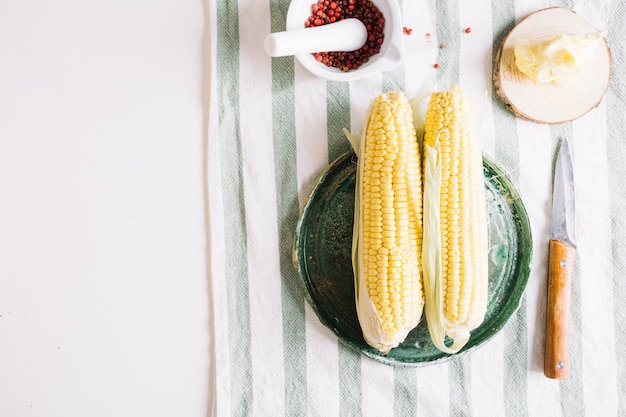There's something magical about corn on the cob. The sweet, juicy kernels bursting with flavour, the satisfying snap as you bite into them – it's pure summer delight. But let's be honest, it can be a bit of a culinary gamble. Overcook it, and you're left with mushy, flavourless disappointment. Undercook it, and you're chewing on tough, unyielding kernels. (Part 1)
The Anatomy of a perfect corn on the Cob

Let's start with what we're aiming for. The ideal corn on the cob should be a symphony of textures and flavours:
- Tender and Juicy: Each bite should be a delightful experience, with the kernels yielding easily to your teeth, releasing a burst of sweet, fresh flavour. Think of it like a perfectly ripe peach – smooth, juicy, and satisfyingly soft.
- Sweet: Corn's natural sweetness is what makes it so irresistible. We want to make sure that sweetness shines through, not masked by overcooked mushiness.
- Brightly Coloured: A vibrant yellow or white colour signifies freshness and flavour. The more vibrant the colour, the better the quality of the corn.
- Cooked Evenly: No one wants a mix of tender and tough kernels. A perfectly cooked ear means every single kernel has reached peak tenderness.
Now, the key to achieving that perfect corn on the cob lies in the cooking method. That's where our journey begins.(Part 2)
cooking corn on the Cob: The Different Methods

There are a few different ways to cook corn on the cob, each with its own unique qualities and advantages. Here's a closer look at each method:
Boiling
Boiling is the tried-and-true method for cooking corn on the cob. It's simple, straightforward, and requires minimal equipment. However, it can be a bit tricky to nail the timing, especially if you're cooking multiple ears at once.
Here's how to boil corn on the cob:
- Fill a large pot with enough water to cover the corn ears comfortably.
- Bring the water to a rolling boil over high heat.
- Add the corn ears to the boiling water, ensuring they're completely submerged.
- Return the water to a boil, then reduce the heat to a gentle simmer. This will ensure even cooking.
- Cook for 5-10 minutes, depending on the thickness of the ears. A general rule of thumb is 5 minutes for thinner ears and 10 minutes for thicker ears.
- Remove the corn ears from the water using tongs or a slotted spoon.
- Serve immediately or refrigerate for later use.
For extra flavour, consider adding a tablespoon of salt and a teaspoon of sugar to the boiling water. This helps season the corn and enhance its natural sweetness.
Grilling
grilling corn on the cob is a delightful way to add a smoky depth of flavour and a touch of char. It's a little more hands-on than boiling, but the effort is worth it.
Here's how to grill corn on the cob:
- Preheat your grill to medium heat.
- Remove the husks and silks from the corn ears.
- Brush the corn ears with olive oil and season generously with salt and pepper. You can also add other seasonings like paprika, chili powder, or garlic powder.
- Place the corn ears directly on the grill grate.
- Cook for 10-15 minutes, turning every 2-3 minutes to ensure even cooking and a beautiful char.
- Remove from the grill and serve immediately.
Microwave
The microwave offers a quick and easy way to cook corn on the cob, ideal for smaller batches or when you're short on time. However, it's not the best option for achieving that deep, rich flavour or beautiful char.
Here's how to microwave corn on the cob:
- Place the corn ears in a microwave-safe dish.
- Add 1/2 cup of water to the dish.
- Microwave on high for 3-5 minutes, depending on the thickness of the ears.
- Remove the corn ears from the microwave carefully, as they will be hot.
- Serve immediately.
Roasting
roasting corn on the cob in the oven is a great option for larger batches. It allows you to cook multiple ears without having to constantly monitor the stovetop or grill.
Here's how to roast corn on the cob:
- Preheat your oven to 400°F (200°C).
- Remove the husks and silks from the corn ears.
- Brush the corn ears with olive oil and season with salt and pepper.
- Place the corn ears on a baking sheet. You can use a baking rack for better airflow.
- Roast for 20-25 minutes, turning every few minutes to ensure even cooking and a slight char.
- Remove from the oven and serve immediately.
Factors Affecting cooking time

While the cooking times mentioned above provide a general guideline, there are several factors that can influence the perfect cooking time for your corn on the cob.
Thickness of the Ears
The thickness of the corn ear plays a crucial role in determining how long it takes to cook. Thicker ears will need a bit more time to reach the desired tenderness. A general rule of thumb is to add an extra minute or two for every 1/4 inch in thickness.
Age of the Corn
Freshly picked corn cooks faster than older corn. If your corn has been sitting in the fridge for a while, it's a good idea to add a minute or two to the cooking time.
Your Preference
Ultimately, the perfect cooking time depends on your personal preference. Some people prefer their corn on the cob cooked until it's very tender, while others like a bit of a bite. It's a matter of taste!(Part 4)
How to Tell When Corn is Done
Knowing when your corn is perfectly cooked is key to achieving that sweet, tender delight. Here's how to tell:
Testing with a Sharp Knife
The classic method is to use a sharp knife to test the kernels. Insert the knife into a kernel near the cob. If the kernel is easy to pierce and the knife glides through effortlessly, your corn is ready. If it's still tough, it needs more time.
Taste Test
A simple taste test is a great way to check for doneness. Break off a small piece of corn and taste it. If it's sweet, tender, and releases a burst of flavour, it's ready to eat.
Checking the Husks
If you're grilling or roasting corn in the husks, check for doneness by seeing how easily the husks pull back. When the husks come off effortlessly, your corn is cooked through.(Part 5)
Top Tips for Perfect Corn on the Cob
Let's talk about some extra tips to ensure your corn on the cob is cooked to perfection.
Tip 1: Fresher is Better
The fresher the corn, the sweeter and more tender it will be. If possible, buy your corn from a local farmer's market or pick it yourself. The corn will taste so much better, and you'll have a chance to choose the freshest ears.
Tip 2: Don't Overcook
Overcooked corn will be mushy and flavourless. It's better to undercook corn than overcook it. You can always cook it a little longer if you're not sure if it's done. But once it's overcooked, there's no going back!
Tip 3: Salt the Water
Salting the water for boiling corn helps to season the corn and enhance its natural flavour. Use about 1 tablespoon of salt per gallon of water.
Tip 4: Butter and Seasonings
Once your corn on the cob is cooked, it's time to dress it up. I like to melt butter and add salt, pepper, and a squeeze of lemon juice. Get creative and experiment with other seasonings like garlic powder, chili powder, or herbs like parsley or chives.
Tip 5: Add a Splash of Sugar
This might sound strange, but adding a pinch of sugar to your boiling water can actually amplify the sweetness of the corn. Try it, you might be surprised! (Part 6)
What to Serve with Corn on the Cob
Corn on the cob is a versatile side dish that pairs well with a variety of main courses. Here are a few ideas:
Barbecue
Corn on the cob is a classic barbecue side dish. It's perfect with grilled chicken, ribs, and burgers. Imagine the smoky flavour of the grill mingling with the sweet, tender corn – pure barbecue heaven!
Seafood
Corn on the cob goes great with grilled or baked fish, especially salmon or mahi-mahi. The sweet corn complements the delicate flavours of the fish beautifully.
Mexican Dishes
Corn on the cob is a staple in Mexican cuisine. It's delicious with tacos, burritos, and enchiladas. The sweetness of the corn adds a delightful contrast to the spicy and savoury flavours of Mexican dishes.
Salads
For a lighter meal, add grilled or roasted corn on the cob to your summer salads. It adds a burst of colour, texture, and flavour to your salads. (Part 7)
How to Store Leftover Corn
If you have leftover corn on the cob, you can store it in the fridge for up to 3 days.
Here's how:
- Wrap the corn ears tightly in plastic wrap or place them in a sealed container.
- Store in the refrigerator for up to 3 days.
To reheat leftover corn, you can microwave it on high for 1-2 minutes or wrap it in foil and bake it in a preheated oven at 350°F (175°C) for 10-15 minutes.(Part 8)
FAQs
1. Can I cook corn on the cob without husks?
Yes, you can cook corn on the cob without husks. Just make sure to remove the silks and brush the corn ears with oil before cooking. Cooking corn without husks allows the kernels to absorb more flavour, and it's a great option for grilling or roasting.
2. How long does it take to cook corn on the cob in the microwave?
It takes about 3-5 minutes to cook corn on the cob in the microwave, depending on the thickness of the ears. However, the microwave isn't ideal for achieving that perfect tenderness and depth of flavour.
3. Can I freeze corn on the cob?
Yes, you can freeze corn on the cob. First, blanch the corn ears in boiling water for 3-5 minutes. Then, drain the corn ears and plunge them into ice water to stop the cooking process. Once the corn ears are cool, wrap them tightly in plastic wrap and freeze for up to 6 months. To use frozen corn, simply thaw it overnight in the refrigerator and then cook it as usual.
4. How can I tell if corn on the cob is fresh?
To tell if corn on the cob is fresh, look for corn ears with green husks that are tightly wrapped around the kernels. The silks should be moist and not dry. The kernels should be plump and firm. If you push a kernel with your fingernail, it should dent slightly but not be soft.
5. What are the best corn varieties for grilling?
Some popular corn varieties for grilling include:
- Silver Queen: This variety has a sweet flavour and tender kernels, making it a classic choice for grilling.
- Golden Bantam: This variety has a buttery flavour and is known for its bright yellow kernels. It holds up well on the grill, developing a lovely char.
- Shuck-Less: This variety is specifically bred to have husks that can be eaten, making it easier to grill. Simply remove the silks and place the entire ear on the grill.
I hope this guide helps you cook the perfect corn on the cob every time! Enjoy those sweet, juicy kernels!
Everyone is watching

Prime Rib Roast Cooking Time Chart: Per Pound Guide
Cooking TipsPrime rib roast. Just the name conjures images of lavish dinners, crackling fires, and hearty laughter. It’s ...

How Long to Bake Potatoes in the Oven (Perfect Every Time)
Cooking TipsBaked potatoes are a staple in my kitchen. They're incredibly versatile, delicious, and surprisingly easy to m...

Perfect Rice Every Time: The Ultimate Guide to Cooking Rice
Cooking TipsAs a self-proclaimed foodie, I've always been a bit obsessed with rice. It's the foundation of countless cuisi...

The Ultimate Guide to Cooking Asparagus: Tips, Techniques, and Recipes
Cooking TipsAsparagus. The mere mention of this spring delicacy conjures up images of vibrant green spears, crisp and burs...

Ultimate Guide to Cooking the Perfect Thanksgiving Turkey
Cooking TipsThanksgiving. Just the word conjures up images of overflowing tables laden with delicious food, the scent of r...
